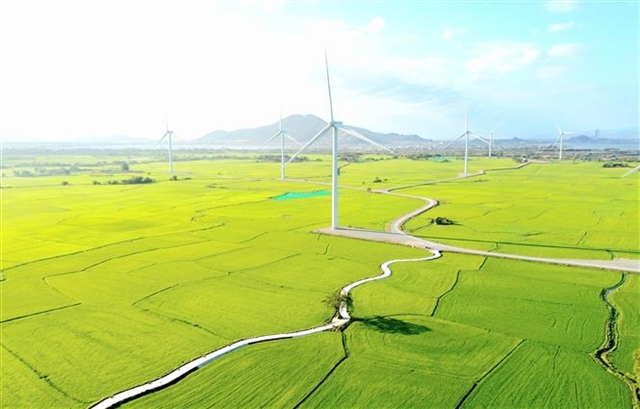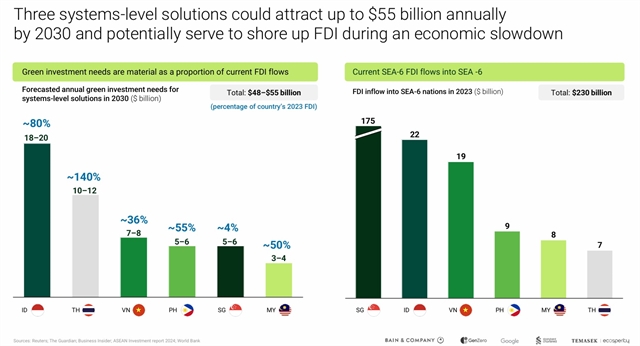Green investment in SEA-6 reached US$8 billion in 2024, a 43 per cent increase year-on-year, with Việt Nam standing out for its growing green investment momentum.

HÀ NỘI — Southeast Asia must pursue a systemic approach to unlock green growth that strengthens economic resilience, narrows up to 50 per cent of the region’s emissions gap by 2030, and potentially adds US$120 billion to regional GDP.
This vision is at the heart of the sixth edition of the Southeast Asia Green Economy report, recently released by Bain & Company in collaboration with GenZero, Google, Standard Chartered and Temasek.
Green investment in SEA-6 reached US$8 billion in 2024 – up 43 per cent year-on-year. Among SEA-6 economies, Việt Nam stands out for its green investment momentum.
SEA-6 refers to Indonesia, Malaysia, the Philippines, Singapore, Thailand and Việt Nam.
In 2024, Việt Nam attracted $161 million in private green investment – roughly 2 per cent of the SEA-6 total and down 19 per cent year-on-year. The structure of this investment is evolving, shifting away from solar power into wind energy and low-carbon transportation.
Despite a slowdown last year, Việt Nam now boasts one of the highest shares of renewable energy in the region, reaching 43 per cent.
According to the report, the Vietnamese Government is actively laying the groundwork for a sustainable energy future through national strategies such as the Power Development Plan VIII (PDP8), the National Energy Master Plan and the National Climate Change Strategy to 2050.
It is also scaling up energy infrastructure, with about 3,000 EV charging stations being rolled out, and enforcing mandatory emissions reporting for key industries. These measures align with the systemic solutions highlighted in the regional report.
The report identifies systemic barriers to green development, such as underdeveloped infrastructure, regulatory fragmentation, limited access to finance and reliance on fossil fuels. Addressing these barriers requires coordinated actions across energy, transport, land use, and industry. With Việt Nam's commitment to net-zero emissions by 2050, the nation is increasingly being seen as a regional leader in green transition efforts.
According to the report, key regional opportunities lie in transforming agriculture and land use (sustainable bioeconomy), modernising electricity grids, and expanding electric vehicle ecosystems.
In SEA, bioeconomy activities contribute up to 33 per cent of employment but are also a major source of deforestation and emissions. Reforms in land rights, supply chains, and natural capital management are needed.
At the same time, grid modernisation – through cross-border interconnections and decentralised energy systems – can support higher renewable integration. Green Industrial Clusters are proposed as near-term models to attract private capital into renewable generation and transmission.
Meanwhile, transport emissions continue to rise across SEA. Việt Nam, with its growing urbanisation and industrial base, is encouraged to adopt a dual strategy of increasing domestic EV production while meeting growing consumer demand.
The report also pointed out that regional 'green corridors' are viewed as critical to accelerating fleet electrification, especially for commercial vehicles, while Asia Pacific region (APAC) cooperation could further strengthen value through shared investment and supply chain integration.

Financing bottleneck
While green investment in SEA-6 increased by 43 per cent year-on-year, there remains an annual green finance gap exceeding $50 billion. Việt Nam, like regional peers, must continue expanding blended finance models, simplify administrative procedures, and mobilise public–private partnerships.
International capital inflows are growing, with foreign investment outside the APAC region into SEA-6 green projects tripling in 2024. However, domestic investment fell by 40 per cent, signalling the need for more stable internal financing mechanisms.
Standard Chartered, which operates across ASEAN, reaffirmed its commitment to supporting Việt Nam’s transition.
Nguyễn Thúy Hạnh, CEO of Standard Chartered Việt Nam, emphasised the country's leadership in building a low-carbon economy, saying that sustainable finance and regional cooperation would be pivotal for long-term prosperity.
Carbon market development is also gaining traction. Yet, unlocking its full potential requires stronger policy frameworks, demand generation, and robust infrastructure. Việt Nam, as part of regional efforts, is expected to align with international standards such as ICVCM (Integrity Council for the Voluntary Carbon Market) and CORSIA (Carbon Offsetting and Reduction Scheme for International Aviation), to ensure credit integrity and investor confidence.
“Southeast Asia’s carbon markets are gaining momentum, but we can do more to unlock their full climate and economic potential,” said Anshari Rahman, Director of Policy and Analytics at GenZero.
“To deliver lasting social and economic gains, supply must also meet international benchmarks like ICVCM and CORSIA – where global demand is headed.”
Additionally, Artificial intelligence (AI) is both a risk and a solution. Data centres could add 2 per cent to emissions by 2030, but with clean energy and smart AI, they can help cut emissions. Sectors like agriculture and energy could see a 3–5 per cent drop if countries like Việt Nam invest in AI.
“With just five years to 2030, our window for action to avoid the worst effects of climate change is rapidly closing. We need to increase the momentum and focus on pragmatic solutions with near-term impact,” said Franziska Zimmermann, Managing Director, Sustainability, Temasek. — BIZHUB/VNS





